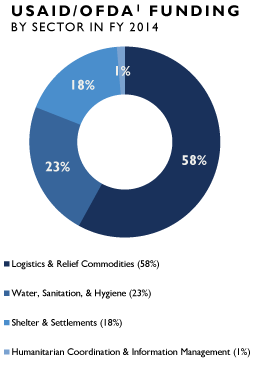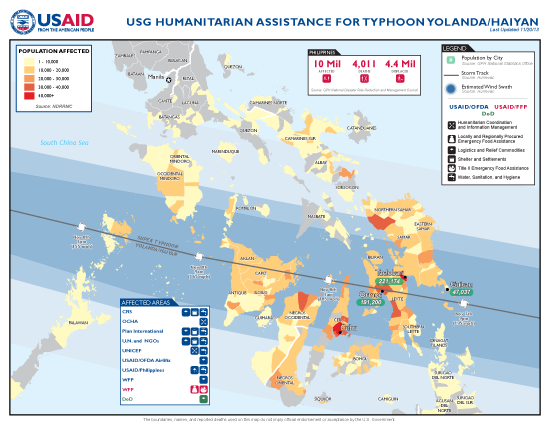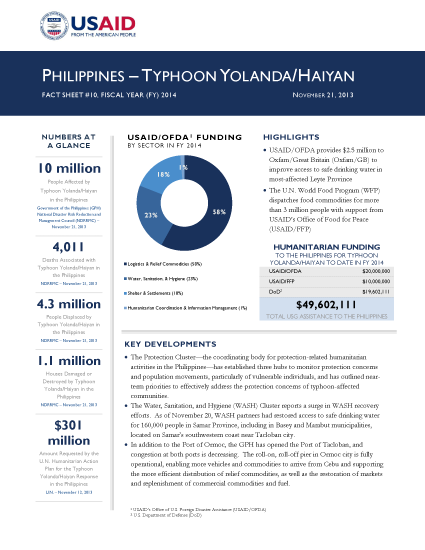- What We Do
- Agriculture and Food Security
- Democracy, Human Rights and Governance
- Economic Growth and Trade
- Education
- Ending Extreme Poverty
- Environment and Global Climate Change
- Gender Equality and Women's Empowerment
- Global Health
- Water and Sanitation
- Working in Crises and Conflict
- Disaster Assistance
- Political Transition Initiatives
- Conflict Mitigation and Prevention
- Countering Violent Extremism
- Disaster Risk Reduction
- Peacebuilding and Reconciliation
- Providing Safe & Secure Environments for Development
- Recovering From Crisis
- Resilience
- Tech Challenge for Atrocity Prevention
- World Humanitarian Day
- U.S. Global Development Lab
November 21, 2013
Numbers At A Glance
10 million
4,011
4.3 million
1.1 million
$301 million
Humanitarian Funding:
To The Philippines For Typhoon Haiyan/Yolanda To Date In FY2014:

| USAID/OFDA | $20,000,000 |
| USAID/FFP | $10,000,000 |
| DoD | $19,602,111 |
| TOTAL | $49,602,111 |
Typhoon Haiyan / Yolanda Fact Sheet #10 - 11/21/2013 ![]() (pdf - 214k)
(pdf - 214k)
Highlights
USAID/OFDA provides $2.5 million to Oxfam/Great Britain (Oxfam/GB) to improve access to safe drinking water in most-affected Leyte Province
The U.N. World Food Program (WFP) dispatches food commodities for more than 3 million people with support from USAID’s Office of Food for Peace (USAID/FFP)
Key Developments
The Protection Cluster—the coordinating body for protection-related humanitarian activities in the Philippines—has established three hubs to monitor protection concerns and population movements, particularly of vulnerable individuals, and has outlined near-term priorities to effectively address the protection concerns of typhoon-affected communities.
The Water, Sanitation, and Hygiene (WASH) Cluster reports a surge in WASH recovery efforts. As of November 20, WASH partners had restored access to safe drinking water for 160,000 people in Samar Province, including in Basey and Marabut municipalities, located on Samar’s southwestern coast near Tacloban city.
In addition to the Port of Ormoc, the GPH has opened the Port of Tacloban, and congestion at both ports is decreasing. The roll-on, roll-off pier in Ormoc city is fully operational, enabling more vehicles and commodities to arrive from Cebu and supporting the more efficient distribution of relief commodities, as well as the restoration of markets and replenishment of commercial commodities and fuel.
LOGISTICS AND RELIEF COMMODITIES
- Logistics Cluster members continue to report improvements in land, sea, and air logistics capacity. Despite significant progress in debris removal over the past several days, debris continues to hinder access to some remote areas.
- WFP reports that two U.N. Humanitarian Air Service (UNHAS) helicopters with the capacity to transport 10 passengers and one fixed-wing aircraft that can transport nine passengers are operational out of Cebu to serve the humanitarian community. In addition, three C-130 fixed-wing aircraft are exclusively serving the Logistics Cluster. Congestion at the Tacloban airport had eased significantly as of November 20, according to the U.N.
- The WFP-contracted container vessel that departed Cebu on November 20 has arrived in Tacloban, transporting mobile storage units (MSUs) and emergency relief commodities for several humanitarian organizations, including two USAID/OFDA partners. In addition, the Logistics Cluster has chartered a roll-on, roll-off cargo vessel—with the capacity to transport 5,000 metric tons (MT)—to assist with humanitarian operations for one month. Ferry service between Matnog, Sorsogon Province—a main access point to Samar from the north—and Allen, Northern Samar Province, has added four barges to transport passengers and vehicles, improving surface access from Manila and other points north to affected areas, according to the NDRRMC.
- To date, WFP has delivered 10 MSUs to Tacloban—four from Cebu via the recently arrived container vessel and six via airlift from Manila—enabling WFP to augment storage capacity in Tacloban. WFP has procured six additional MSUs in Manila for onward transport to Tacloban. WFP has deployed 70 staff to the Philippines for the typhoon response operation.
- USAID/OFDA has provided $5 million to date to support WFP logistics operations in the Philippines.
PROTECTION
- Protection Cluster partners have identified six near-term protection priorities, which include promoting the physical safety of affected populations; tracing missing persons and starting family tracing and reunification (FTR) programs; improving access to assistance; replacing identification documentation, such as birth certificates; supporting the needs of vulnerable populations and people with special needs; and promoting the use of the guiding principles for internal displacement, particularly to prevent involuntary returns. Protection partners are also concerned about the risk of sexual exploitation and abuse by humanitarian workers and military personnel.
- The Protection Cluster has set up tents at the Tacloban airport—equipped with computers, generators, and other equipment provided by the Office of the U.N. High Commissioner for Refugees (UNHCR)—to register people leaving affected areas and to determine support available upon arrival at their destination. A team of GPH Department of Social Welfare and Development (DSWD), International Organization for Migration (IOM), and non-governmental organization (NGO) personnel will undertake the registration activities.
- IOM has activated its Displacement Tracking Matrix at 41 evacuation centers in Tacloban and Roxas, providing information on the priority concerns and needs of 15,000 people to date.
- A DART protection advisor remains in country and is working alongside the Protection Cluster and other technical experts to encourage adoption of best practices to mitigate elevated risks associated with disasters.
WASH AND HEALTH
- Health Cluster partners report that emergency medical needs are declining as health efforts shift toward focusing on primary health care, reproductive health care, protection, and psychosocial support.
- As of November 19, Health Cluster partners had assessed 942 of the 2,495 health facilitates, mainly hospitals, in affected areas, reporting that 104—or 11 percent—are not functioning, according to the U.N. The Health Cluster continues to map health facility damage.
- The GPH Department of Health (DoH) reports that 54 Filipino health teams, 43 foreign medical teams, and 13 local teams—comprising more than 1,400 people—are providing health services in typhoon-affected areas. The DoH reports that the health supply pipeline is improving and the logistical capacity of health activities is increasing as roads are cleared and ground transportation improves.
- The U.N. reports that an estimated 390,000 pregnant and lactating women require specialized service for prenatal, postnatal, child health, health promotion, and family planning. An estimated 865 women give birth each day in typhoon-affected areas.
- The U.N. Population Fund (UNFPA) is providing reproductive health kits to health partners for distribution, procuring equipment to address reproductive health care needs, and establishing five rural health clinics to provide primary health care, including basic emergency obstetric care, in typhoon-affected areas.
- Water supply has been partially restored in most areas of Eastern and Western Visayas regions, according to the NDRRMC. In Guiuan, three of the five water pumps that serve the municipality are not functioning, according to the U.N. In Tacloban, municipal public works officials have confirmed that water being produced at the city’s pumping stations is safe for drinking.
- On November 21, USAID/OFDA committed approximately $2.5 million to Oxfam/GB to improve access to safe drinking water for 200,000 people in Leyte Province, including in Tacloban city. Oxfam/GB will work with provincial government authorities to repair broken pipes and other damage to the municipal water system caused by Typhoon Yolanda/Haiyan. To complement the water supply intervention, Oxfam/GB will also conduct sanitation and hygiene promotion interventions to reinforce the safe water supply.
EMERGENCY FOOD ASSISTANCE
- As of November 21, WFP and DSWD had dispatched food commodities for an estimated 3 million beneficiaries, exceeding the original target of 2.5 million people.
- To date, WFP has dispatched 1,212 MT of rice and 13 MT of high-energy biscuits (HEBs) or emergency food products (EFPs) for more than 2.1 million beneficiaries from its Tacloban hub. Additionally, WFP has dispatched sufficient rice, HEBs, and EFPs for nearly 200,000 people from its Ormoc hub and approximately 710,000 beneficiaries from its Guiuan hub. WFP has also dispatched HEBs to Roxas city and Bantayan Island. USAID/FFP has provided Title II EFPs from its pre-positioning warehouse in Miami, Florida, to WFP and is supporting WFP to locally procure rice for distribution to typhoon-affected populations. WFP plans to expand distribution activities from the three main hubs to more remote areas that have not yet received WFP food commodities.
- In recent days, WFP has worked with DSWD to distribute WFP rice in bulk 50 kilogram bags to municipalities for onward distribution by mayors and municipal leaders. WFP reports that the current blanket distribution of food commodities will transition into a more targeted approach in the coming weeks.
INTERNATIONAL ASSISTANCE
- As of November 21, international donors had pledged approximately $306 million to address humanitarian needs among populations affected by Typhoon Yolanda/Haiyan. The total amount pledged exceeds the $301 million requested by the U.N. Humanitarian Action Plan for the Philippines typhoon response.









Comment
Make a general inquiry or suggest an improvement.